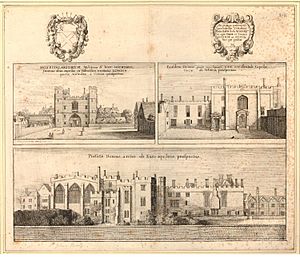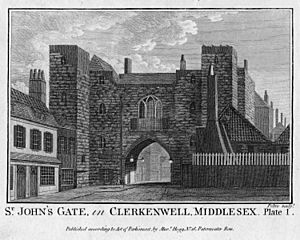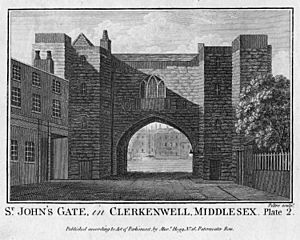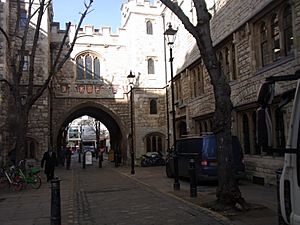Clerkenwell Priory facts for kids

The Clerkenwell Priory was a large religious building in Clerkenwell, London. It was the main home in England for the Knights Hospitallers of St John of Jerusalem. These knights were a special group of Christian warriors who followed the Augustinian rule. They were known for helping pilgrims and fighting in the Crusades. The Priory was where their leader in England, called the Grand Prior, lived. It also owned a lot of land nearby, like St John's Wood, which provided food and money.
Contents
History
How it Started
The Priory was founded by a Norman baron named Jordan Briset during the time of King Henry II. This was around 1185. The church of the Priory was officially opened by the Patriarch Heraclius from Jerusalem. King Henry II even held an important meeting there. Heraclius tried to convince the King to send English soldiers to a new crusade.
Busy Medieval Times
The Clerkenwell Priory was a very active place. In 1237, a group of Hospitaller knights left the Priory to go on a Crusade. They marched through London with their banners, showing their dedication.
The Priory was also a place where many important people stayed. It was the only Hospitaller priory in England that struggled to cover its own costs because it had to host the Grand Prior and many guests. For example, in 1337, it spent more than it earned. Kings like King John (in 1212), Edward, Prince of Wales (in 1265), Henry IV (in 1399), and Henry V (in 1413) all visited the Priory.
Fire and Rebuilding
Sadly, the Priory was badly damaged by fire during the Peasants' Revolt in 1381. It took a long time to rebuild. By 1504, it was fully restored. Sir Thomas Docwra, who was the Grand Prior at the time, built a grand new south gate. People said the rebuilt Priory looked like a palace, with a beautiful church and a tall, impressive tower.
When the Priory Closed Down
In the early 1500s, King Henry VIII decided to close down many monasteries and religious houses in England. This was known as the Dissolution. He closed Clerkenwell Priory because the Knights Hospitaller supported the Pope, which went against the King's new rules for the Church in England.
The last prior, William Weston, and other officers of the order were given small payments, so they didn't fight against the closure. Most of the Knights moved to their main base in Malta. Henry VIII then used the Priory church and other buildings to store his hunting equipment.
Changes Over Time
After Henry VIII, his son King Edward VI gave the Priory's remaining lands to other noblemen. Much of the Priory church was destroyed, and its stones were used to build other important buildings in London, like the Lord Protector's house.
When Queen Mary I came to the throne, she brought back the order and returned their property. The church was repaired, and religious services were held there again. However, when Queen Elizabeth I became queen, the order was sent back to Malta once more.
During Elizabeth's reign, the Priory buildings were used by her Master of the Revels, who was in charge of court entertainment. Tailors, painters, and stage crews worked there, and the great hall was used for play rehearsals. Later, the buildings were given to different noble families.
The 17th Century and Beyond
In 1623, the choir of the church was reopened. Later, it became a private chapel and then a meeting place for a different religious group called the Presbyterians. In 1723, the building was bought and became the local parish church, St John Clerkenwell.
Today
Today, not much of the original Clerkenwell Priory remains. The most famous part is Docwra's south gate, which has been rebuilt over the years and is now a well-known landmark. There is also an old Early English crypt (an underground room) that still exists beneath the nearby parish church. Some stone from the priory even ended up in Exmouth, Devon, used in a building for the St John Ambulance Brigade.




